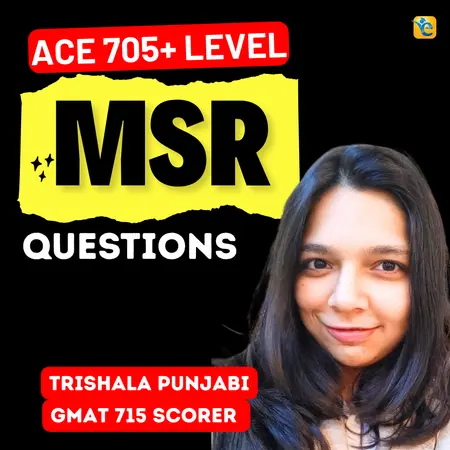Events & Promotions
|
|

GMAT Club Daily Prep
Thank you for using the timer - this advanced tool can estimate your performance and suggest more practice questions. We have subscribed you to Daily Prep Questions via email.
Customized
for You
Track
Your Progress
Practice
Pays
Not interested in getting valuable practice questions and articles delivered to your email? No problem, unsubscribe here.
- Nov 19
12:30 PM EST
-01:30 PM EST
Learn how Keshav, a Chartered Accountant, scored an impressive 705 on GMAT in just 30 days with GMATWhiz's expert guidance. In this video, he shares preparation tips and strategies that worked for him, including the mock, time management, and more - Nov 18
11:00 AM PST
-12:00 PM PST
Join us in a live GMAT practice session and solve 30 challenging GMAT questions with other test takers in timed conditions, covering GMAT Quant, Data Sufficiency, Data Insights, Reading Comprehension, and Critical Reasoning questions. - Nov 20
01:30 PM EST
-02:30 PM IST
Learn how Kamakshi achieved a GMAT 675 with an impressive 96th %ile in Data Insights. Discover the unique methods and exam strategies that helped her excel in DI along with other sections for a balanced and high score. - Nov 22
11:00 AM IST
-01:00 PM IST
Do RC/MSR passages scare you? e-GMAT is conducting a masterclass to help you learn – Learn effective reading strategies Tackle difficult RC & MSR with confidence Excel in timed test environment - Nov 23
11:00 AM IST
-01:00 PM IST
Attend this free GMAT Algebra Webinar and learn how to master the most challenging Inequalities and Absolute Value problems with ease. - Nov 24
07:00 PM PST
-08:00 PM PST
Full-length FE mock with insightful analytics, weakness diagnosis, and video explanations! - Nov 25
10:00 AM EST
-11:00 AM EST
Prefer video-based learning? The Target Test Prep OnDemand course is a one-of-a-kind video masterclass featuring 400 hours of lecture-style teaching by Scott Woodbury-Stewart, founder of Target Test Prep and one of the most accomplished GMAT instructors.
E
Be sure to select an answer first to save it in the Error Log before revealing the correct answer (OA)!
Difficulty:
 5%
(low)
5%
(low)
Question Stats:
88% (01:00) correct 12%
(01:15)
wrong
12%
(01:15)
wrong  based on 4834
sessions
based on 4834
sessions
History
Date
Time
Result
Not Attempted Yet
Of all the vast tides of migration that have swept through history, maybe none is more concentrated as the wave that brought 12 million immigrants onto American shores in little more than three decades.
(A) maybe none is more concentrated as
(B) it may be that none is more concentrated as
(C) perhaps it is none that is more concentrated than
(D) maybe it is none that was more concentrated than
(E) perhaps none was more concentrated than
(A) maybe none is more concentrated as
(B) it may be that none is more concentrated as
(C) perhaps it is none that is more concentrated than
(D) maybe it is none that was more concentrated than
(E) perhaps none was more concentrated than
Show Spoilernytimes article
https://www.nytimes.com/1992/03/22/books/in-short-nonfiction-first-steps.html
Of all the vast tides of migration that have swept through history and through every continent in the world, probably none was more concentrated than the wave that washed 12 million immigrants onto American shores in little more than three decades.
Of all the vast tides of migration that have swept through history and through every continent in the world, probably none was more concentrated than the wave that washed 12 million immigrants onto American shores in little more than three decades.
Kudos
Bookmarks
sujit2k7
Excellent example - thanks for sharing it across.
In rare cases you may see the GMAT use a placeholder "it" to place awkward subjects or objects later in the sentence. These placeholder "it" situations are fairly easy to spot because "it" will be sitting in the first position as the subject or object instead of appearling later on in the sentence after the antecedent (subject/object).
Placeholder It situations:
It was faster to walk home than to wait for the bus. [infinitive subject now appears at the end of the sentence]
It was hard knowing that we lost the game because we were lazy. [that-clause subject now appears at the end]
The monsoon rains made it possible for us to canoe in our backyard [infinitive subject appears at end].
Normal Pronoun It situations
The business had to close because it ran out of cash. [replacing the subject]
I love that dog because it never barks at night. [replacing the object]
Again, placeholder it situations are rare, but as you pointed out they can appear in a GMAT sentence!
KW
Kudos
Bookmarks
gtr022001
D has many issues:
1. "is" is in present tense, while the sentence demands past tense.
2. "it" is not required in D as the pronoun "it" does not refer to any antecedent. Hence, it more acts like a demonstrative pronoun, which is not required here.
3. When you say "it is none that was", you are stressing on "none", while the sentence construction does not need this stress.
4. Just another thought - "maybe" is an informal use of "perhaps". "perhaps" is formal. But, just this does not clearly make D wrong.
Thanks,
Arun















